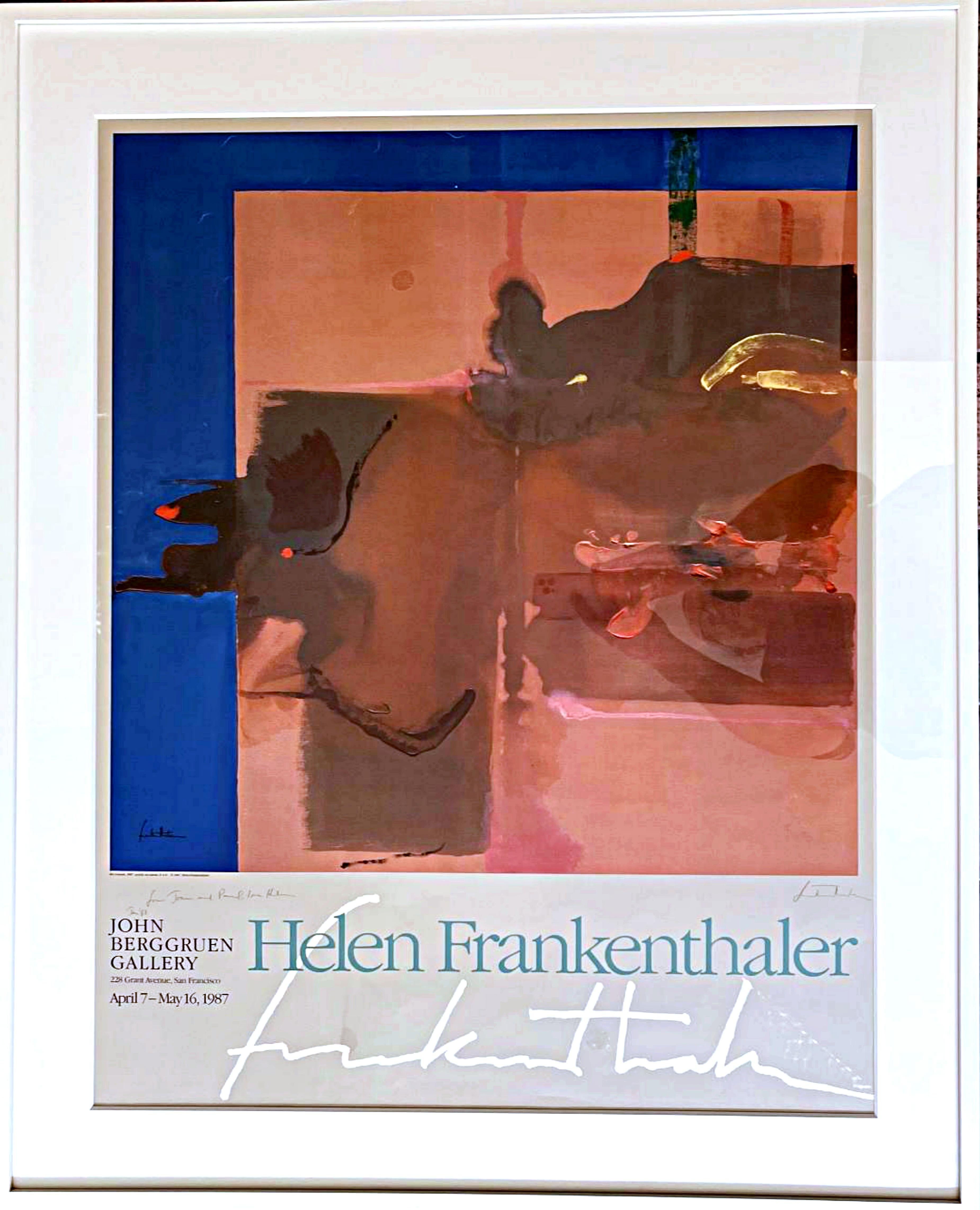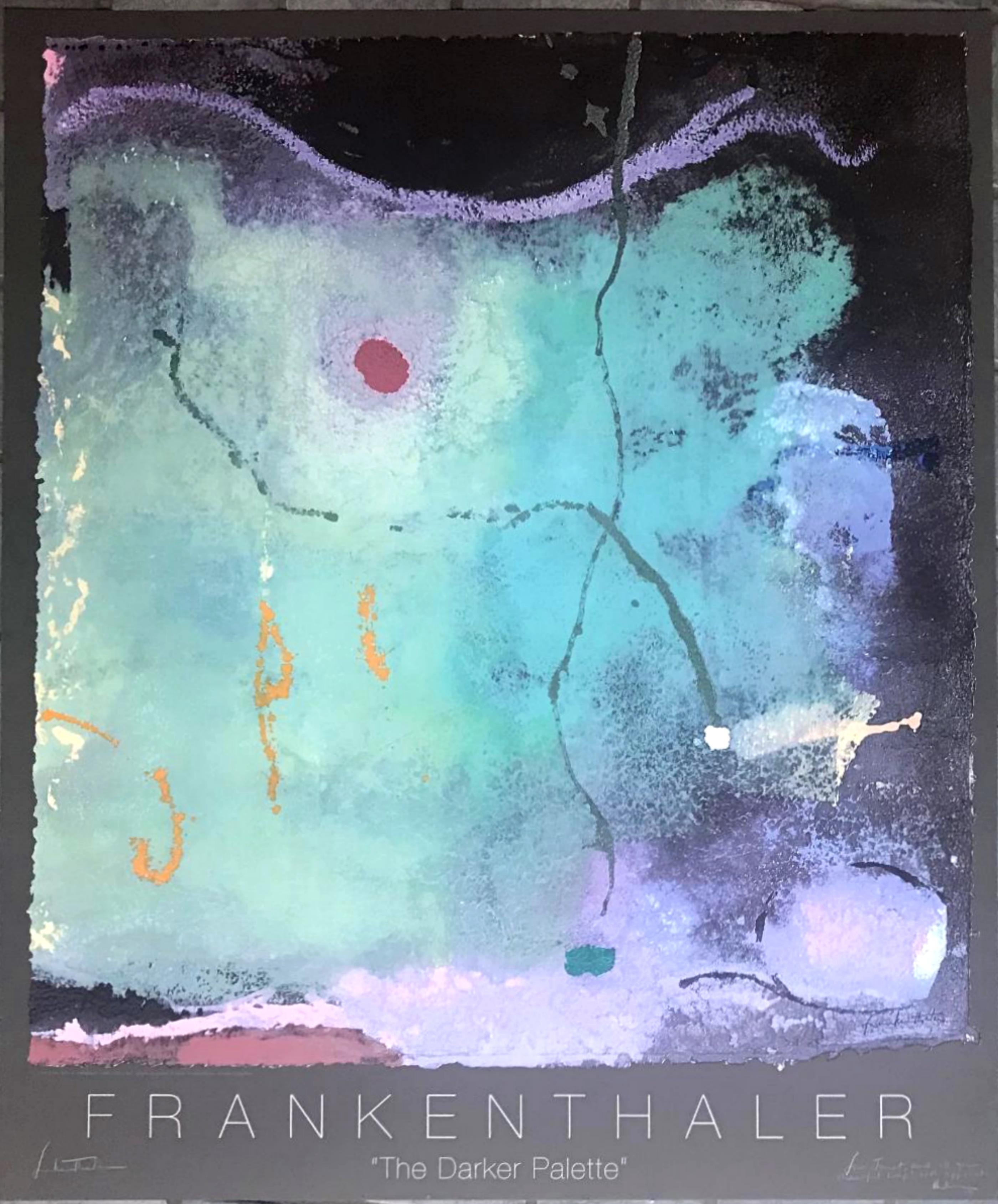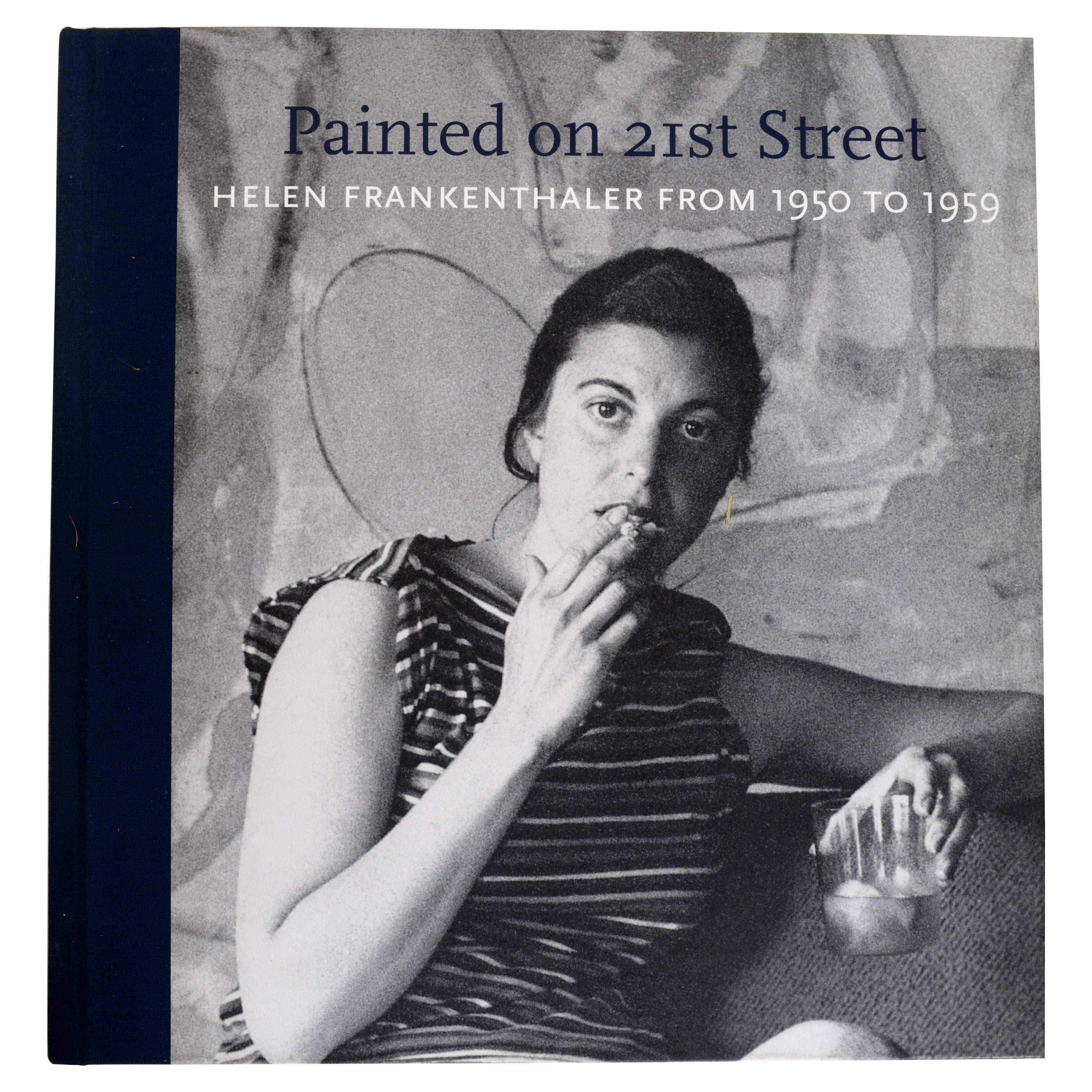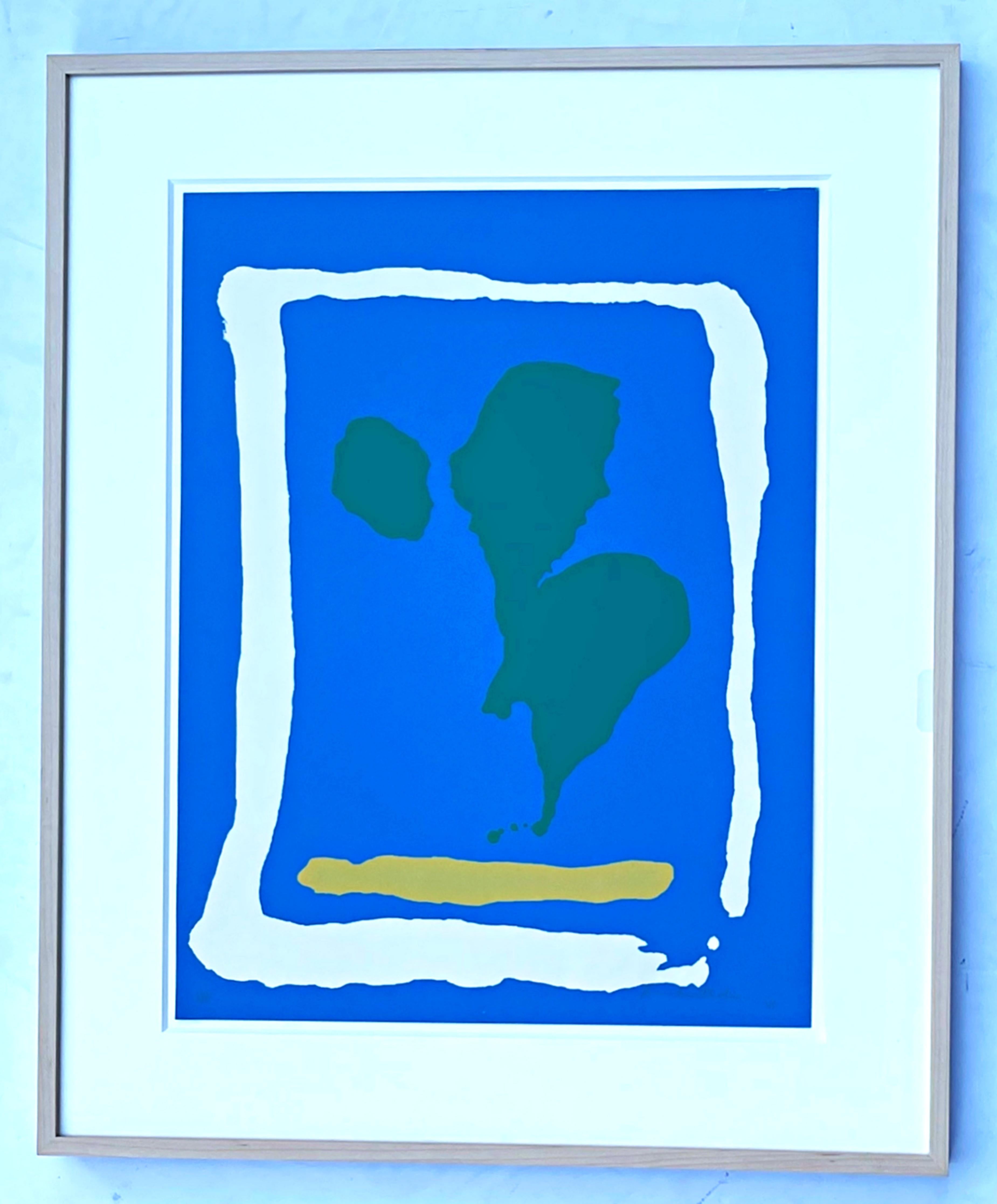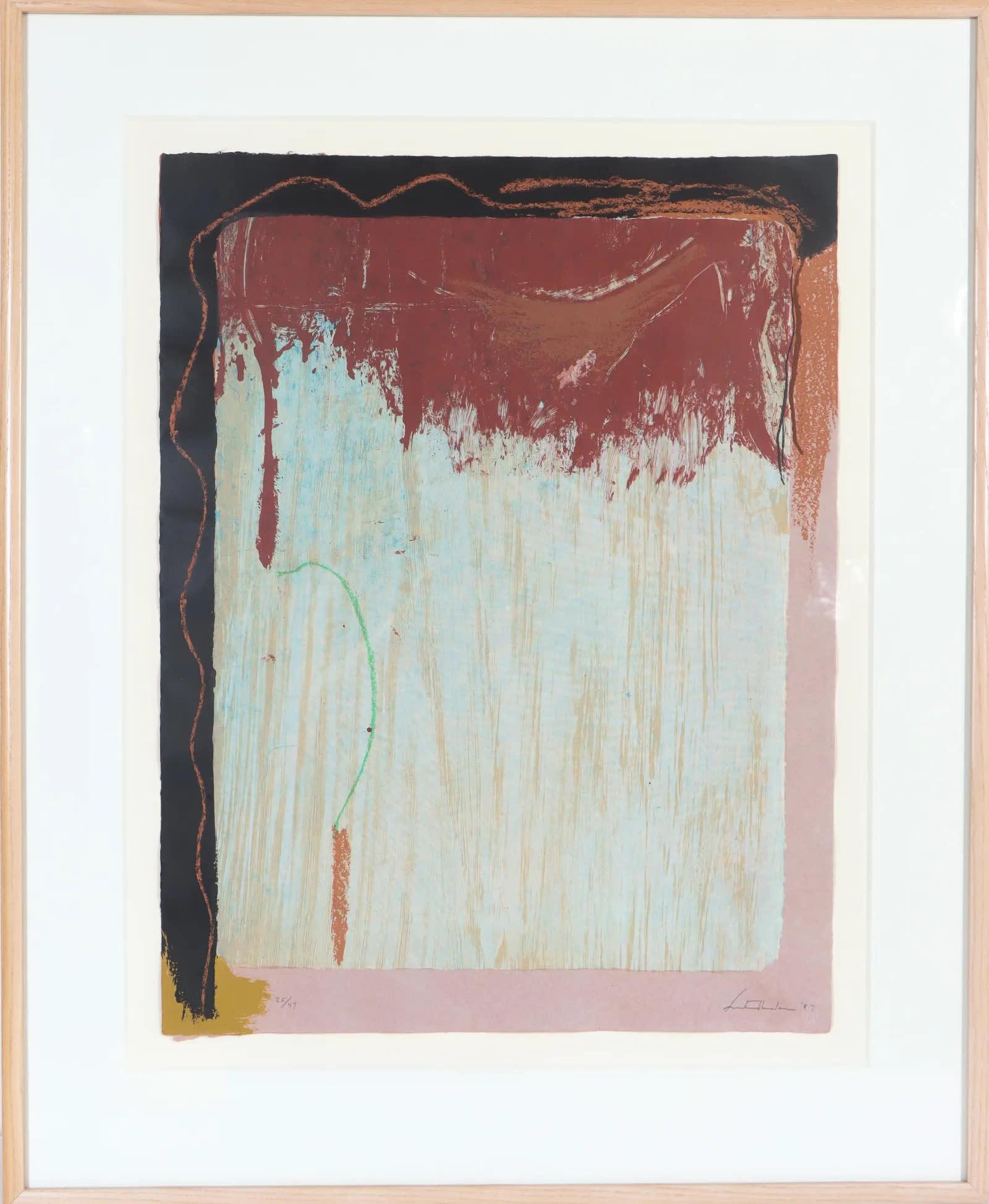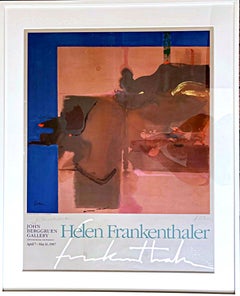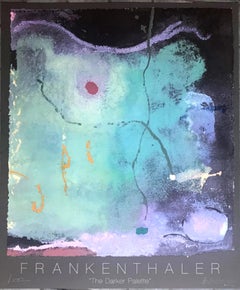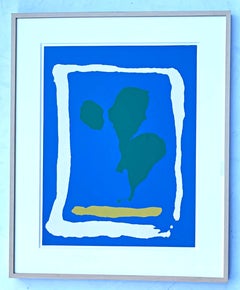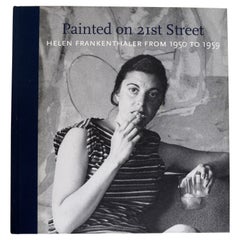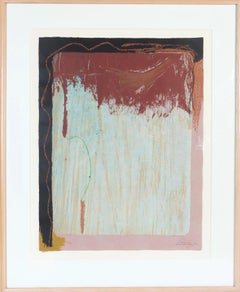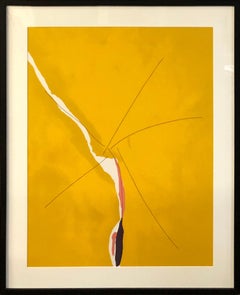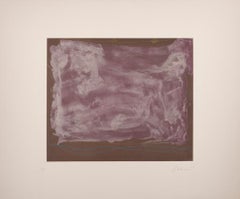Items Similar to Book: Works on Paper 1949-1984 (Hand signed & inscribed by Helen Frankenthaler)
Want more images or videos?
Request additional images or videos from the seller
1 of 9
Book: Works on Paper 1949-1984 (Hand signed & inscribed by Helen Frankenthaler)1986
1986
$880
£685.12
€779.10
CA$1,265.19
A$1,389.42
CHF 725.58
MX$16,583.35
NOK 9,192.44
SEK 8,567.72
DKK 5,818.83
About the Item
Helen Frankenthaler (after)
Frankenthaler, Works on Paper 1949-1984 (Hand signed and inscribed to Dick Polich, Founder of Tallix Foundry), 1986
Softcover monograph (book), hand signed and dated by Helen Frankenthaler and warmly inscribed to Dick Polich
The inscription reads, “For Dick and Tony, and hopefully more trips to the new Tallix. Sincerely, Helen Frankenthaler June ’86.”
Tallix is the famous foundry where every major sculptor in America would cast their works. They also did some interesting 3D projects with painters like Helen Frankenthaler as well. Dick Polich ran the foundry.
10 × 9 × 2 inches
Published by George Braziller in collaboration with the International Exhibitions Foundation
Signed, dated and warmly inscribed by Helen Frankenthaler to Dick Polich (founder of the famed Tallix Fine Art Foundry) and his partner
This vintage softcover monograph on Helen Frankenthaler's works on paper, written by art historian Karen Wilkin, is warmly inscribed on the title page by the artist to Dick Polich, the Founder of the legendary Tallix Art Foundry and Polich Art Works, in which Helen mentions her desire to continue to do work with Tallix. The provenance is impeccable as it was acquired from the collection of Dick Polich.
HELEN FRANKENTHALER BIOGRAPHY
A line, color, shapes, spaces, all do one thing for and within themselves, and yet do something else, in relation to everything that is going on within the four sides [of the canvas]. A line is a line, but [also] is a color. . . . It does this here, but that there. The canvas surface is flat and yet the space extends for miles. What a lie, what trickery—how beautiful is the very idea of painting.
—Helen Frankenthaler
Helen Frankenthaler (1928–2011), whose career spanned six decades, has long been recognized as one of the great American artists of the twentieth century. A member of the second generation of postwar American abstract painters, she is widely credited with playing a pivotal role in the transition from Abstract Expressionism to Color Field painting. Through her invention of the soak-stain technique, she expanded the possibilities of abstraction, while at times referencing figuration and landscape in highly personal ways. She produced a body of work whose impact on contemporary art has been profound and continues to grow.
Frankenthaler was born on December 12, 1928, and raised in New York. She attended the Dalton School, where she received her earliest art instruction from Rufino Tamayo. In 1949 she graduated from Bennington College, Vermont, where she was a student of Paul Feeley, following which she studied briefly with Hans Hofmann.
Frankenthaler exhibited her work professionally for the first time in 1950, at the Kootz Gallery in New York, when Adolph Gottlieb selected her painting Beach (1950) for inclusion in Fifteen Unknowns: Selected by Artists of the Kootz Gallery. Her first solo exhibition was presented in 1951, at New York’s Tibor de Nagy Gallery, and that year she was also included in the landmark 9th St. Exhibition of Paintings and Sculpture in New York.
In 1952 Frankenthaler created Mountains and Sea, her breakthrough soak-stain painting. She poured thinned paint directly onto raw, unprimed canvas laid on the studio floor, working from all sides to create floating fields of translucent color. Mountains and Sea was immediately influential for the artists who formed the Color Field school of painting, notable among them Morris Louis and Kenneth Noland.
As early as 1959 Frankenthaler began to be a regular presence in major international exhibitions. That year she won first prize at the Première Biennale de Paris, and in 1966 she represented the United States at the 33rd Biennale di Venezia, alongside Ellsworth Kelly, Roy Lichtenstein, and Jules Olitski. She had her first museum retrospective in 1960, at New York’s Jewish Museum, and her second in 1969, at the Whitney Museum of American Art, New York, followed by an international tour. Additional museum retrospectives have been held at the Solomon R. Guggenheim Museum, New York, and touring venues (1985, works on paper); Modern Art Museum of Fort Worth, Texas, and touring venues, including Museum of Modern Art, New York (1989, paintings); National Gallery of Art, Washington, DC, and touring venues (1993, prints); Naples Museum of Art, Florida, and touring venues, including Yale University Art Gallery, New Haven, Connecticut (2002, woodcuts); and Museum of Contemporary Art, North Miami, Florida, and touring venue, Royal Scottish Academy, Edinburgh, Scotland (2003, works on paper).
- Creation Year:1986
- Dimensions:Height: 10 in (25.4 cm)Width: 9 in (22.86 cm)Depth: 2 in (5.08 cm)
- Medium:
- Movement & Style:
- After:Helen Frankenthaler (1928, American)
- Period:
- Condition:Good vintage condition; shelf wear and age wear to the outer covers but the interior pages are clean and crisp and the signature page with inscription is excellent.
- Gallery Location:New York, NY
- Reference Number:1stDibs: LU1745216447932
About the Seller
5.0
Platinum Seller
Premium sellers with a 4.7+ rating and 24-hour response times
Established in 2007
1stDibs seller since 2022
463 sales on 1stDibs
Typical response time: 2 hours
- ShippingRetrieving quote...Shipping from: New York, NY
- Return Policy
More From This Seller
View AllAbstract Expressionist Poster (Hand signed and inscribed by Helen Frankenthaler)
By Helen Frankenthaler
Located in New York, NY
Helen Frankenthaler (after)
Frankenthaler (autographedand inscribed), 1988
Offset lithograph poster (hand signed and inscribed to renowned collectors)
Hand signed and warmly inscribed in ink on the front
Frame included: Museum frame with UV plexiglass included
Inscribed "to Paul and Joan, love Helen Frankenthaler" (Paul and Joan Gluck were major art collectors)
Measurements:
Framed
42 inches vertical by 34 inches by 1.75 inches
Print
34.5 inches vertical by 27 inches
Helen Frankenthaler, A Brief Biography
Helen Frankenthaler (1928-2011), whose career spanned six decades, has long been recognized as one of the great American artists of the twentieth century. She was eminent among the second generation of postwar American abstract painters and is widely credited for playing a pivotal role in the transition from Abstract Expressionism to Color Field painting. Through her invention of the soak-stain technique, she expanded the possibilities of abstract painting, while at times referencing figuration and landscape in unique ways. She produced a body of work whose impact on contemporary art has been profound and continues to grow.
Frankenthaler was born on December 12, 1928, and raised in New York City. She attended the Dalton School, where she received her earliest art instruction from Rufino Tamayo. In 1949 she graduated from Bennington College, Vermont, where she was a student of Paul Feeley. She later studied briefly with Hans Hofmann
Frankenthaler’s professional exhibition career began in 1950, when Adolph Gottlieb selected her painting Beach (1950) for inclusion in the exhibition titled Fifteen Unknowns: Selected by Artists of the Kootz Gallery. Her first solo exhibition was presented in 1951, at New York’s Tibor de Nagy Gallery, and that year she was also included in the landmark exhibition 9th St. Exhibition of Paintings and Sculpture.
In 1952 Frankenthaler created Mountains and Sea, a breakthrough painting of American abstraction for which she poured thinned paint directly onto raw, unprimed canvas laid on the studio floor, working from all sides to create floating fields of translucent color. Mountains and Sea was immediately influential for the artists who formed the Color Field school of painting, notable among them Morris Louis and Kenneth Noland.
As early as 1959, Frankenthaler began to be a regular presence in major international exhibitions. She won first prize at the Premiere Biennale de Paris that year, and in 1966 she represented the United States in the 33rd Venice Biennale, alongside Ellsworth Kelly, Roy Lichtenstein, and Jules Olitski. She had her first major museum exhibition in 1960, at New York’s Jewish Museum, and her second, in 1969, at the Whitney Museum of American Art, followed by an international tour.
Frankenthaler experimented tirelessly throughout her long career. In addition to producing unique paintings on canvas and paper, she worked in a wide range of media, including ceramics, sculpture, tapestry, and especially printmaking. Hers was a significant voice in the mid-century “print renaissance” among American abstract painters, and she is particularly renowned for her woodcuts. She continued working productively through the opening years of this century.
Frankenthaler’s distinguished, prolific career has been the subject of numerous monographic museum exhibitions. The Jewish Museum and Whitney Museum shows were succeeded by a major retrospective initiated by the Modern Art Museum of Fort Worth that traveled to The Museum of Modern Art, New York, the Los Angeles County Museum of Art, and the Detroit Institute of Arts, MI (1989); and those devoted to works on paper and prints organized by the National Gallery of Art, Washington, D.C. (1993), among others.
Select recent important exhibitions have included Painted on 21st Street: Helen Frankenthaler from 1950 to 1959 (Gagosian, NY, 2013); Making Painting: Helen Frankenthaler and JMW Turner (Turner Contemporary, Margate, UK, 2014); Giving Up One’s Mark: Helen Frankenthaler in the 1960s and 1970s (Albright-Knox Art Gallery, Buffalo, NY, 2014–15); Pretty Raw: After and Around Helen Frankenthaler (Rose Art Museum, Brandeis University, Waltham, MA, 2015); As in Nature: Helen Frankenthaler, Paintings and No Rules: Helen Frankenthaler Woodcuts...
Category
1980s Abstract Abstract Prints
Materials
Offset
The Darker Palette print, Hand signed twice and inscribed by Helen Frankenthaler
By Helen Frankenthaler
Located in New York, NY
Helen Frankenthaler (after)
Frankenthaler: The Darker Palette (autographed and inscribed), 1998
Offset Lithograph print
42 × 35 in
hand signed "Frankenthaler" lower left; inscribed a...
Category
1990s Abstract Expressionist Abstract Prints
Materials
Offset, Lithograph
A Paintings Retrospective: vintage LACMA Museum poster depicting her 1963 work
By Helen Frankenthaler
Located in New York, NY
Helen Frankenthaler (after)
A Paintings Retrospective: vintage LACMA Museum poster, 1990
Offset lithograph museum poster
(Unsigned & Unnumbered)
37 × 25 inches
Unframed
This was printed in the artists lifetime - making it more collectible - on the occasion of the exhibition, "Helen Frankenthaler: A Paintings Retrospective from February to April, 1990 at the Los Angeles County Museum of Art (LACMA)
Print is published by Editions Limited Galleries, San Francisco for Los Angeles County Museum of Art (LACMA), LA, CA
The work depicted is Helen Frankenthaler, The Bay, 1963, acrylic on canvas, Detroit Institute of Arts, Michigan (Incidentally, this beautiful work is featured on the cover of the book Water and Art' by David Clarke.)
“What concerns me when I work is not whether a picture is a landscape… or whether somebody will see a sunset in it. What concerns me is, did I make a beautiful picture?” - - Helen Frankenthaler
This is Frankenthaler's first silkscreen, produced for the portfolio New York Ten, which includes works by other New York-based artists at the time such as Roy Lichtenstein, Jim Dine, Tom Wesselmann and Claes Oldenburg. (She created her first lithograph in 1961)
Other examples of this edition are found in the permanent collections of the Museum of Modern Art, MOCA Chicago, the Metropolitan Museum, the Philadelphia Museum, the Art Institute of Chicago, and numerous regional museums and institutions in the United States and worldwide.
Helen Frankenthaler, A Brief Biography
Helen Frankenthaler (1928-2011), whose career spanned six decades, has long been recognized as one of the great American artists of the twentieth century. She was eminent among the second generation of postwar American abstract painters and is widely credited for playing a pivotal role in the transition from Abstract Expressionism to Color Field painting. Through her invention of the soak-stain technique, she expanded the possibilities of abstract painting, while at times referencing figuration and landscape in unique ways. She produced a body of work whose impact on contemporary art has been profound and continues to grow.
Frankenthaler was born on December 12, 1928, and raised in New York City. She attended the Dalton School, where she received her earliest art instruction from Rufino Tamayo. In 1949 she graduated from Bennington College, Vermont, where she was a student of Paul Feeley. She later studied briefly with Hans Hofmann.
Frankenthaler’s professional exhibition career began in 1950, when Adolph Gottlieb selected her painting Beach (1950) for inclusion in the exhibition titled Fifteen Unknowns: Selected by Artists of the Kootz Gallery. Her first solo exhibition was presented in 1951, at New York’s Tibor de Nagy Gallery, and that year she was also included in the landmark exhibition 9th St. Exhibition of Paintings and Sculpture.
In 1952 Frankenthaler created Mountains and Sea, a breakthrough painting of American abstraction for which she poured thinned paint directly onto raw, unprimed canvas laid on the studio floor, working from all sides to create floating fields of translucent color. Mountains and Sea was immediately influential for the artists who formed the Color Field school of painting, notable among them Morris Louis and Kenneth Noland.
As early as 1959, Frankenthaler began to be a regular presence in major international exhibitions. She won first prize at the Premiere Biennale de Paris that year, and in 1966 she represented the United States in the 33rd Venice Biennale, alongside Ellsworth Kelly, Roy Lichtenstein, and Jules Olitski. She had her first major museum exhibition in 1960, at New York’s Jewish Museum, and her second, in 1969, at the Whitney Museum of American Art, followed by an international tour.
Frankenthaler experimented tirelessly throughout her long career. In addition to producing unique paintings on canvas and paper, she worked in a wide range of media, including ceramics, sculpture, tapestry, and especially printmaking. Hers was a significant voice in the mid-century “print renaissance” among American abstract painters, and she is particularly renowned for her woodcuts. She continued working productively through the opening years of this century.
Frankenthaler’s distinguished, prolific career has been the subject of numerous monographic museum exhibitions. The Jewish Museum and Whitney Museum shows were succeeded by a major retrospective initiated by the Modern Art Museum of Fort Worth that traveled to The Museum of Modern Art, New York, the Los Angeles County Museum of Art, and the Detroit Institute of Arts, MI (1989); and those devoted to works on paper and prints organized by the National Gallery of Art, Washington, D.C. (1993), among others.
Select recent important exhibitions have included Painted on 21st Street: Helen Frankenthaler from 1950 to 1959 (Gagosian, NY, 2013); Making Painting: Helen Frankenthaler and JMW Turner (Turner Contemporary, Margate, UK, 2014); Giving Up One’s Mark: Helen Frankenthaler in the 1960s and 1970s (Albright-Knox Art Gallery, Buffalo, NY, 2014–15); Pretty Raw: After and Around Helen Frankenthaler (Rose Art Museum, Brandeis University, Waltham, MA, 2015); As in Nature: Helen Frankenthaler, Paintings and No Rules: Helen Frankenthaler Woodcuts...
Category
1990s Abstract Expressionist Abstract Prints
Materials
Offset, Lithograph
Helen Frankenthaler, Air Frame (Harrison 6) her first silkscreen Signed AP 1965
By Helen Frankenthaler
Located in New York, NY
Helen Frankenthaler
Air Frame, from the New York Ten portfolio (Harrison 6), 1965
Color silkscreen on Arches double-weight watercolor paper
Signed and annotated AP in graphite on the front; this is an Artist's Proof, aside from the regular edition of 200
“What concerns me when I work is not whether a picture is a landscape… or whether somebody will see a sunset in it. What concerns me is, did I make a beautiful picture?” - - Helen Frankenthaler
Pencil signed AP, one of 25 proofs aside from the regular edition of 200
Catalogue Raisonne: Harrison 6, Berggruen 7, Clark 6
Printed by Chiron Press, New York. Published by Tanglewood Press, New York.
This work has been newly framed in a museum quality wood frame under UV plexiglass. The original label from the famed John Berggruen Gallery in California has been affixed to the back to preserve provenance.
Other examples of this coveted 1965 work can be found in major institutional and museum collections worldwide.
Measurements:
Framed
29 inches vertical by 24 inches (horizontal) by 1.5 inches
Artwork:
22 inches vertical x 17 inches horizontal
This is Frankenthaler's first silkscreen, produced for the portfolio New York Ten, which includes works by other New York-based artists at the time such as Roy Lichtenstein, Jim Dine, Tom Wesselmann and Claes Oldenburg. (She created her first lithograph in 1961)
Other examples of this edition are found in the permanent collections of the Museum of Modern Art, MOCA Chicago, the Metropolitan Museum, the Philadelphia Museum, the Art Institute of Chicago, and numerous regional museums and institutions in the United States and worldwide.
Helen Frankenthaler, A Brief Biography
Helen Frankenthaler (1928-2011), whose career spanned six decades, has long been recognized as one of the great American artists of the twentieth century. She was eminent among the second generation of postwar American abstract painters and is widely credited for playing a pivotal role in the transition from Abstract Expressionism to Color Field painting. Through her invention of the soak-stain technique, she expanded the possibilities of abstract painting, while at times referencing figuration and landscape in unique ways. She produced a body of work whose impact on contemporary art has been profound and continues to grow.
Frankenthaler was born on December 12, 1928, and raised in New York City. She attended the Dalton School, where she received her earliest art instruction from Rufino Tamayo. In 1949 she graduated from Bennington College, Vermont, where she was a student of Paul Feeley. She later studied briefly with Hans Hofmann.
Frankenthaler’s professional exhibition career began in 1950, when Adolph Gottlieb selected her painting Beach (1950) for inclusion in the exhibition titled Fifteen Unknowns: Selected by Artists of the Kootz Gallery. Her first solo exhibition was presented in 1951, at New York’s Tibor de Nagy Gallery, and that year she was also included in the landmark exhibition 9th St. Exhibition of Paintings and Sculpture.
In 1952 Frankenthaler created Mountains and Sea, a breakthrough painting of American abstraction for which she poured thinned paint directly onto raw, unprimed canvas laid on the studio floor, working from all sides to create floating fields of translucent color. Mountains and Sea was immediately influential for the artists who formed the Color Field school of painting, notable among them Morris Louis and Kenneth Noland.
As early as 1959, Frankenthaler began to be a regular presence in major international exhibitions. She won first prize at the Premiere Biennale de Paris that year, and in 1966 she represented the United States in the 33rd Venice Biennale, alongside Ellsworth Kelly, Roy Lichtenstein, and Jules Olitski. She had her first major museum exhibition in 1960, at New York’s Jewish Museum, and her second, in 1969, at the Whitney Museum of American Art, followed by an international tour.
Frankenthaler experimented tirelessly throughout her long career. In addition to producing unique paintings on canvas and paper, she worked in a wide range of media, including ceramics, sculpture, tapestry, and especially printmaking. Hers was a significant voice in the mid-century “print renaissance” among American abstract painters, and she is particularly renowned for her woodcuts. She continued working productively through the opening years of this century.
Frankenthaler’s distinguished, prolific career has been the subject of numerous monographic museum exhibitions. The Jewish Museum and Whitney Museum shows were succeeded by a major retrospective initiated by the Modern Art Museum of Fort Worth that traveled to The Museum of Modern Art, New York, the Los Angeles County Museum of Art, and the Detroit Institute of Arts, MI (1989); and those devoted to works on paper and prints organized by the National Gallery of Art, Washington, D.C. (1993), among others.
Select recent important exhibitions have included Painted on 21st Street: Helen Frankenthaler from 1950 to 1959 (Gagosian, NY, 2013); Making Painting: Helen Frankenthaler and JMW Turner (Turner Contemporary, Margate, UK, 2014); Giving Up One’s Mark: Helen Frankenthaler in the 1960s and 1970s (Albright-Knox Art Gallery, Buffalo, NY, 2014–15); Pretty Raw: After and Around Helen Frankenthaler (Rose Art Museum, Brandeis University, Waltham, MA, 2015); As in Nature: Helen Frankenthaler, Paintings and No Rules: Helen Frankenthaler Woodcuts...
Category
1960s Abstract Expressionist Abstract Prints
Materials
Screen
Silkscreen from the estate of Stephen Poleskie, Berggruen 11, Clark 12 Harrison
By Helen Frankenthaler
Located in New York, NY
Helen Frankenthaler
Untitled, from the estate of Stephen Poleskie (Berggruen 11, Clark 12, Harrison and Boorsch 11), 1967
Color silkscreen on wove paper
Unframed
A unique unsigned pr...
Category
1960s Abstract Expressionist Abstract Prints
Materials
Screen
Ron Gorchov Mid Century Modern Abstract Expressionist painting on paper Signed
By Ron Gorchov
Located in New York, NY
Ron Gorchov
Untitled early 1960s Abstract Expressionist work, 1962
Ink and watercolor painting on paper
Signed and dated in black ink lower left recto
Frame included:
elegantly floa...
Category
1960s Abstract Expressionist Abstract Drawings and Watercolors
Materials
Ink, Watercolor
You May Also Like
Painted on 21st St Helen Frankenthaler from 1950-1959 by John Elderfield, 1st Ed
Located in valatie, NY
Painted on 21st Street, Helen Frankenthaler from 1950-1959 by John Elderfield. Published by Gagosian Gallery / Abrams, New York, 2013. 1st Ed Exhibition hardcover catalog, no dust jacket as issued. Gagosian, in cooperation with the Estate of Helen Frankenthaler, presented a major exhibition devoted to Helen Frankenthaler’s paintings...
Category
2010s American Books
Materials
Paper
Tribal Sign
By Helen Frankenthaler
Located in New York, NY
Tribal Sign, 1987
Signed and dated in pencil with publisher's blindstamp
Eleven color lithograph on mauve TGL handmade paper
Sheet: 24 x 18.5 inches
Frame: 33 x 27 inches
Edition 25 ...
Category
1980s Abstract Prints
Materials
Color, Lithograph
Helen Frankenthaler 'Sesame' Vintage
By Helen Frankenthaler
Located in Brooklyn, NY
Silkscreen poster featuring Helen Frankenthaler’s Sesame, showcasing her expressive use of color and fluid form that helped define postwar American abstraction. The artwork is presen...
Category
1990s American Modern Prints and Multiples
Materials
Screen
Soho Dreams
By Helen Frankenthaler
Located in London, GB
Etching, aquatint and drypoint in colours, 1987, on Magnani paper, signed and dated in pencil, numbered from the edition of 71 (there were also 8 artist’s proofs), published by 2RC E...
Category
1980s Abstract Expressionist Abstract Prints
Materials
Drypoint, Etching, Aquatint
Helen Frankenthaler Color Etching
By Helen Frankenthaler
Located in West Palm Beach, FL
Ganymede, 1978
Etching with aquatint
9/49
Pencil signed and dated by the artist.
Category
Vintage 1970s North American Contemporary Art
Materials
Paper
Helen Frankenthaler "Dream Walk" Lithograph, Signed and Numbered 39/47
By Helen Frankenthaler
Located in Toledo, OH
Helen Frankenthaler (1928-2011)
Six color lithograph, Dream Walk, 1977. Number 39 from an edition of 47, pencil lower left corner. Signed and dated 1977 in pencil in lower right cor...
Category
Vintage 1970s American Mid-Century Modern Prints
Materials
Paper
